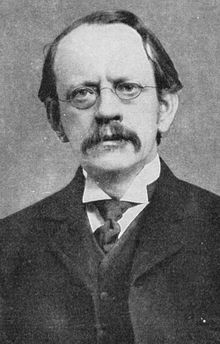
Back J.J. Thomson Afrikaans Joseph John Thomson AN جوزيف جون طومسون Arabic جوزيف جون طومسون ARZ জোছেফ জন টমছন Assamese Joseph John Thomson AST Cozef Con Tomson Azerbaijani جوزف جان تامسون AZB Джозеф Джон Томсан Byelorussian Джозэф Джон Томсан BE-X-OLD
Sir Joseph John Thomson (18 December 1856 – 30 August 1940) was an English physicist who received the Nobel Prize in Physics in 1906 for his discovery of the electron, the first subatomic particle to be found.
In 1897, Thomson showed that cathode rays were composed of previously unknown negatively charged particles (now called electrons), which he calculated must have bodies much smaller than atoms and a very large charge-to-mass ratio.[1] Thomson is also credited with finding the first evidence for isotopes of a stable (non-radioactive) element in 1913, as part of his exploration into the composition of canal rays (positive ions). His experiments to determine the nature of positively charged particles, with Francis William Aston, were the first use of mass spectrometry and led to the development of the mass spectrograph.[1][2]
Thomson was awarded the 1906 Nobel Prize in Physics for his work on the conduction of electricity in gases.[3] Thomson was also a teacher, and seven of his students went on to win Nobel Prizes: Ernest Rutherford (Chemistry 1908), Lawrence Bragg (Physics 1915), Charles Barkla (Physics 1917), Francis Aston (Chemistry 1922), Charles Thomson Rees Wilson (Physics 1927), Owen Richardson (Physics 1928) and Edward Victor Appleton (Physics 1947).[4] Only Arnold Sommerfeld's record of mentorship offers a comparable list of high-achieving students.
- ^ a b Cite error: The named reference
Profilewas invoked but never defined (see the help page). - ^ Cite error: The named reference
Joneswas invoked but never defined (see the help page). - ^ "J.J. Thomson – Biographical". The Nobel Prize in Physics 1906. The Nobel Foundation. Retrieved 11 February 2015.
- ^ Sengupta, Sudipto (6 April 2015). "Extraordinary Professor: JJ Thomson and his Nobel Prize Factory". Probashi. Durga Puja & Cultural Association (India). Retrieved 7 August 2022.
His Nobel Laureate students include Rutherford, Aston, Wilson, Bragg, Barkla, Richardson, and Appleton

